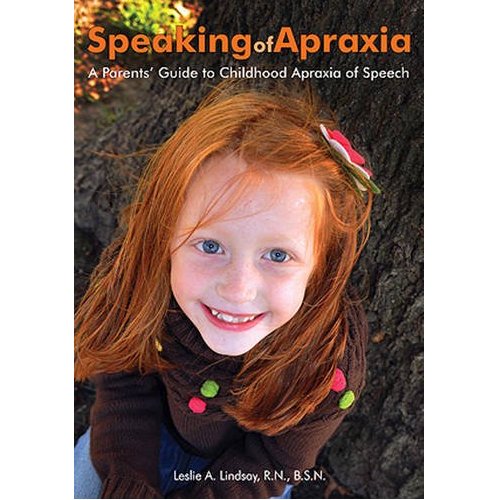 I often get requests to review speech and language materials from apps to toys and books but when “Speaking of Apraxia” arrived I was very impressed. Leslie Lindsay, a former Child and Adolescent Psychiatric Nurse at Mayo Clinic has done her homework. When her daughter was diagnosed with Childhood Apraxia of Speech (CAS), she dug into the research and paired it with her real life experiences as a mom, coping with a new diagnosis, finding the best therapy resources and creating a home environment conducive to progress. This 488 page comprehensive, hands-on guide covers every topic related to apraxia, helping parents navigate their way through finding the best program and resources to help their child with CAS. This will be my go-to guide to share with parents going forth.
I often get requests to review speech and language materials from apps to toys and books but when “Speaking of Apraxia” arrived I was very impressed. Leslie Lindsay, a former Child and Adolescent Psychiatric Nurse at Mayo Clinic has done her homework. When her daughter was diagnosed with Childhood Apraxia of Speech (CAS), she dug into the research and paired it with her real life experiences as a mom, coping with a new diagnosis, finding the best therapy resources and creating a home environment conducive to progress. This 488 page comprehensive, hands-on guide covers every topic related to apraxia, helping parents navigate their way through finding the best program and resources to help their child with CAS. This will be my go-to guide to share with parents going forth.
My thanks to Leslie for her guest post today.:
The Nuts & Bolts of Apraxia
I am thrilled to be a guest blogger on Play on Words, hosted by Sherry Artemenko, CCC-SLP. It is my pleasure to introduce you to SPEAKING OF APRAXIA: A Parent’s Guide to Childhood Apraxia of Speech (CAS). Written in part to understand the disorder when my own daughter was diagnosed—and to help others also walking this path—the book was very much a labor of love. According to ForeWord Review, “[Leslie Lindsay pulls from her personal experience as the mother of a ‘sweet, fun and beautiful’ daughter with apraxia to create a comprehensive, supportive, straightforward tool for other parents needing to learn about this neurological motor speech disorder.”
Published by Woodbine House, a leader in producing top-quality special needs resources since 1985, Speaking of Apraxia offers hope and practical advice for parents of toddlers to teens. Characterized by difficulties with planning and producing the complex set of movements necessary for intelligible speech, CAS can be a child’s only diagnosis or can be accompanied by other special needs such as learning disabilities, Down syndrome, or autism. Parents and professionals will appreciate the clear explanations of everything from diagnosing CAS and working with speech-language pathologists (SLPs), to understanding how to distinguish it from other speech disorders, and getting appropriate early intervention and special education support.
Drawing on the latest research, professionals’ insights, my own and other parents’ experience, these important topics are covered:
- I: The Straight Scoop on Speech Basics–CAS definition; An Overview of Speech & Language; Where to Get Help and What to Ask; Your First Appointment with an SLP
- II: Now What?!–Getting, Coping with and Understanding the Diagnosis; Health & Genetics; All about Speech Therapy
- III: Helping Your Child–Complementary and Alternative Medical and Treatment Approaches (Diet, Music, Movement Therapy and More)
- IV: Off to School–Getting Ready; Special Education Ins & Outs; Phonological Awareness; Reading Issues
- V: Coping & Hoping–Dealing with Emotions and Family Life; What the Future May Hold; Networking, Support Groups, and Advocacy
- Appendices: Information on insurance, summer camps and enrichment programs, speech-language milestones, and a glossary of terms
Short on time? What parent isn’t? Each chapter starts off with a Nuts & Bolts section which gives you a quick glimpse at what that chapter will cover. Also, you will find plenty of text boxes, charts, and other graphics to break up the pages, filled with anecdotes of parents also raising a child with CAS.
One parent shared that one of her favorite parts of the whole book was the end-of-the chapter in which “Read On: Recommended Resources” provides next steps, websites, and books to build on.
“I read [Speaking of Apraxia] in its entirety last night …. Bravo! Loved hearing your story and know that this book will help so many others with so many of their questions. My favorite parts are where you reference children’s books or movies that you have read or seen that remind you of struggles with speech. We plan on watching Charlotte’s Web and I am searching for my copy of Knufflebunny.”
One of my goals in writing Speaking of Apraxia was to give parents an invitation to think outside the box—or as I call it in the book—to tap into their inner speech-language pathologist. It can be very challenging when a parent hears their child is diagnosed with something they’ve never heard of. I wanted to empower parents in the sense that they really have a lot of say (okay, couldn’t resist) in how speech is practiced at home. Thus, this chapter on helping your children at home. A mother of nine—one of whom has CAS shares, “I’m LOVING [this chapter on how to help your children at home]… I think you are right on with your ideas. You have hit on all my favorite apraxia resources, plus SO many I have never heard of.”
As a former child psych R.N., I my favorite sections to write were the ones on family and child coping (chapters 13 & 14). This, to me is really the “meat” of working with CAS. Sure, there’s a lot of speech-pathology one needs to be aware of—all covered in the book—but when it comes right down to it—CAS is a family affair. We all respond differently and having a resource to help cope with the feelings, changes, and unknowns is so important. “The way [Ms. Lindsay] ties in her family’s struggles and worries—and happy times—into this book is remarkable. [She] hits on every feeling and emotion. I cried as I read the first few sentences. Yes, I have been there.”
Speaking of Apraxia is a comprehensive and authoritative resource any family, SLP, occupational therapist, or pediatric practice will be glad to own or recommend.
“[Ms. Lindsay] went above and beyond, really…I sincerely believe this is MUST READ for so many!”
[A] vital addition to any childhood educational research collection, highly recommended.”
–Library Bookwatch, May 2012
When I read these reviews I truly am humbled. As a mother, I hoped to help my daughter and glean a little understanding for myself. Quite literally, I am speechless when I hear I’ve touched the lives of so many. I sincerely hope you will find the book helpful to you and yours.
The book is available thru Amazon, Barnes & Noble (in-stores and on-line), and the publisher’s website, www.woodbinehouse.com
Bio: Leslie Lindsay lives in suburban Chicago with her husband, two daughters, and basset hound. She is working on her next book, a novel. Read her blog at www.leslie4kids.wordpress.com, Follow her on Twitter @LeslieLindsay1, and “like” the Speaking of Apraxia Facebook Page http://www.facebook.com/pages/Speaking-of-Apraxia-A-Parents-Guide-to-Childhood-Apraxia-of-Speech/235772599837084?ref=hl

